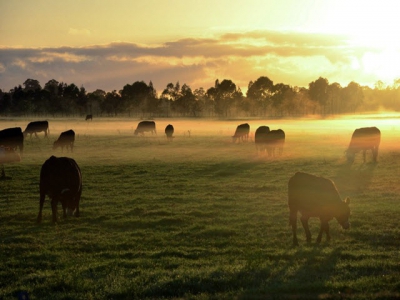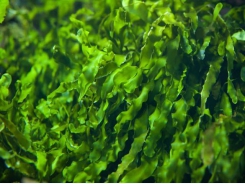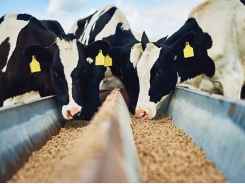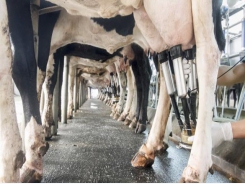Vitamin blend, β-carotene may boost grazing cattle pregnancy rate

Adding a blend of β-carotene and vitamins may improve cattle pregnancy rates for an initial round of fixed-time artificial insemination, say researchers.
A team of researchers in Brazil explored the use of β-carotene and a vitamin blend with grazing beef cows and the influence of the feed additives on reproductive performance. The research team published its work in the journal of Livestock Science.
“We hypothesized that feeding the combination of β-carotene and vitamins for grazing Nellore cows starting 30 days before and throughout the breeding season could enhance pregnancy rate,” the researchers said. “Therefore, the objective of the present study was to evaluate the effects of β-carotene, vitamins ADE and biotin inclusion into mineral supplement on overall reproductive performance of grazing beef cows.”
The researchers found that there were positive connections between the establishment of a pregnancy on the first fixed time artificial insemination (FTAI) and cow body condition score (BCS) 11 days prior. There also were connections to blood β-carotene levels pre-FTAI.
“Including the combination of β-carotene, vitamins ADE and biotin into the mineral supplement increases the pregnancy rate at first FTAI in beef grazing tropical pasture,” they said. “The blood β-carotene status at the beginning of the FTAI protocol is positively correlated with the pregnancy rate in grazing beef cows.”
The study was supported by DSM.
Why β-carotene and vitamin blend?
Vitamins are needed for health and reproduction and lack of nutrients leads to negative symptoms for animals, the researchers said. The potential for carotenoids to play a positive role in cow fertility has been previously explored.
Similarly, dietary vitamin E and vitamin D have been linked to improved outcomes for cow pregnancies, they said. Supplemental biotin is considered to improve metabolic status post-partum.
Tropical grasses can provide a low-quality forage, as the high fiber content and low digestibility may reduced feed intake and animal performance, they said. Cattle raised on tropical grazing may not meet intake requirements.
Cows in tropical environments tend to have a longer postpartum anestrous, which stretches the calving to conception internal and impairs reproductive performance, they said. “This response may be attributed to the reduced nutritional status of cows before the breeding season mainly due [to] the forage quality,” they added.
Methods and materials
In the feeding trial, 430 cows were given one of two diets starting 30 days before fixed-time artificial insemination (FTAI), the researchers said. The diets included a control or grazing system and that diet supplemented with 500mg β-carotene and “70,000 IU Vit. A, 10,000 IU Vit. D3, 500 mg Vit. E and 10 mg biotin/cow/day.”
At the start of the trial, cows were checked for body condition score and total blood carotenoid concentration, they said. The control or supplemented diets were given through the second pregnancy check – or for 101 days.
Pasture samples were collected from all areas grazed for analysis, they said.
The pregnancy rate was checked 30-days post FTAI, they said. Non-pregnant cows were put through a second FTAI protocol and 15-days later cows were exposed to natural mating through the end of the breeding season.
“Thirty days after the second FTAI (day 71) the resynchronized cows had their first pregnancy diagnostic, whereas the females from first FTAI had their pregnancy confirmed,” the researchers said. “At day 101, the pregnant resynchronized cows had their pregnancy confirmed and at day 150 (30 days after the breeding season end), all cows had a final transrectal ultrasonography evaluation for overall pregnancy rate.”
Blood samples were collected on days -30, -11, -1, 30, 39, 71 and 101 – with day 0 being the day of the first FTAI – to check for levels of β-carotene, they said.
Results
Overall, no differences in cyclicity rate (CL) prior to FTAI synchronization efforts were noted, the researchers said. Cows on both diets saw similar estrus patterns.
However, adding the β-carotene and vitamin mix to cow diets was found to alter pregnancy rate at first FTAI, they said. It improved the pregnancy rate following the first FTAI – control pregnancy rate was 57.6% while those on the supplement diet had a pregnancy rate of 66.7%.
“Including the combination of β-carotene, vitamins ADE and biotin into mineral supplement for grazing beef cows increases the conception rate at first FTAI and can be a tool to optimize the reproductive performance,” they said.
The boost to pregnancy rate was not noted following the second round of FTAI, or for those cows going through the natural mating process, they said. At the end of the breeding season, pregnancy rates were similar for both groups of cows regardless of diet.
For the first FTAI embryo size tended to be larger for cows on the supplemented diet, the researchers said.
Cows on the supplemented diet also had larger embryo thoracic width at the second pregnancy diagnostic when compared to cows on the control diet, they said. There also were “positive correlations” between pregnancy rate for the first FTAI and body condition score on day -11.
During the first FTAI the largest follicle diameter was similar for cows on the supplemented and control diets, they said. However, the largest follicle diameter tended to be larger for cows getting the supplemented diet during the second FTAI.
Source: Livestock Science
Authors: Vinícius de Gouvêa, Marcos Colli, Walter Gonçales Jr, Jéssica Motta, Tiago Acedo, Guilherme de Vasconcellos, Luis Tamassia, Flávia Elliff, Rodolfo Mingoti, Pietro Baruselli
Related news
Tools

Phối trộn thức ăn chăn nuôi

Pha dung dịch thủy canh

Định mức cho tôm ăn

Phối trộn phân bón NPK

Xác định tỷ lệ tôm sống

Chuyển đổi đơn vị phân bón

Xác định công suất sục khí

Chuyển đổi đơn vị tôm

Tính diện tích nhà kính

Tính thể tích ao




 Prenatal nutrition may determine long-term outcomes in beef…
Prenatal nutrition may determine long-term outcomes in beef…  Bovine mastitis treatment marks 'significant progress'
Bovine mastitis treatment marks 'significant progress'